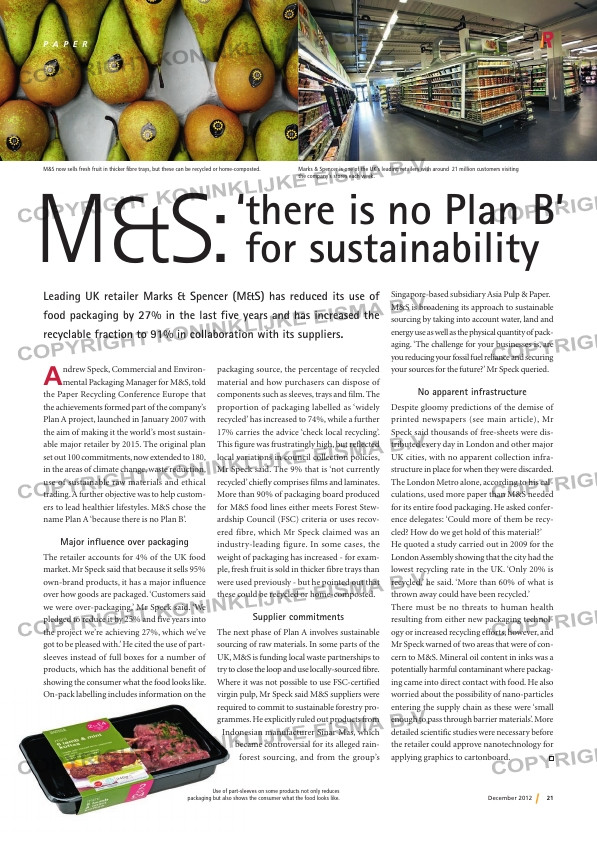Page 21 from: December 2012

21December 2012
p a p e r
Andrew Speck, Commercial and Environ-mental Packaging Manager for M&S, told
the Paper Recycling Conference Europe that
the achievements formed part of the company’s
Plan A project, launched in January 2007 with
the aim of making it the world’s most sustain-
able major retailer by 2015. The original plan
set out 100 commitments, now extended to 180,
in the areas of climate change, waste reduction,
use of sustainable raw materials and ethical
trading. A further objective was to help custom-
ers to lead healthier lifestyles. M&S chose the
name Plan A ‘because there is no Plan B’.
Major influence over packaging
The retailer accounts for 4% of the UK food
market. Mr Speck said that because it sells 95%
own-brand products, it has a major influence
over how goods are packaged. ‘Customers said
we were over-packaging,’ Mr Speck said. ‘We
pledged to reduce it by 25% and five years into
the project we’re achieving 27%, which we’ve
got to be pleased with.’ He cited the use of part-
sleeves instead of full boxes for a number of
products, which has the additional benefit of
showing the consumer what the food looks like.
On-pack labelling includes information on the
M&S:
packaging source, the percentage of recycled
material and how purchasers can dispose of
components such as sleeves, trays and film. The
proportion of packaging labelled as ‘widely
recycled’ has increased to 74%, while a further
17% carries the advice ‘check local recycling’.
This figure was frustratingly high, but reflected
local variations in council collection policies,
Mr Speck said. The 9% that is ‘not currently
recycled’ chiefly comprises films and laminates.
More than 90% of packaging board produced
for M&S food lines either meets Forest Stew-
ardship Council (FSC) criteria or uses recov-
ered fibre, which Mr Speck claimed was an
industry-leading figure. In some cases, the
weight of packaging has increased – for exam-
ple, fresh fruit is sold in thicker fibre trays than
were used previously – but he pointed out that
these could be recycled or home-composted.
Supplier commitments
The next phase of Plan A involves sustainable
sourcing of raw materials. In some parts of the
UK, M&S is funding local waste partnerships to
try to close the loop and use locally-sourced fibre.
Where it was not possible to use FSC-certified
virgin pulp, Mr Speck said M&S suppliers were
required to commit to sustainable forestry pro-
grammes. He explicitly ruled out products from
Indonesian manufacturer Sinar Mas, which
became controversial for its alleged rain-
forest sourcing, and from the group’s
Singapore-based subsidiary Asia Pulp & Paper.
M&S is broadening its approach to sustainable
sourcing by taking into account water, land and
energy use as well as the physical quantity of pack-
aging. ‘The challenge for your businesses is, are
you reducing your fossil fuel reliance and securing
your sources for the future?’ Mr Speck queried.
No apparent infrastructure
Despite gloomy predictions of the demise of
printed newspapers (see main article), Mr
Speck said thousands of free-sheets were dis-
tributed every day in London and other major
UK cities, with no apparent collection infra-
structure in place for when they were discarded.
The London Metro alone, according to his cal-
culations, used more paper than M&S needed
for its entire food packaging. He asked confer-
ence delegates: ‘Could more of them be recy-
cled? How do we get hold of this material?’
He quoted a study carried out in 2009 for the
London Assembly showing that the city had the
lowest recycling rate in the UK. ‘Only 20% is
recycled,’ he said. ‘More than 60% of what is
thrown away could have been recycled.’
There must be no threats to human health
resulting from either new packaging technol-
ogy or increased recycling efforts, however, and
Mr Speck warned of two areas that were of con-
cern to M&S. Mineral oil content in inks was a
potentially harmful contaminant where packag-
ing came into direct contact with food. He also
worried about the possibility of nano-particles
entering the supply chain as these were ‘small
enough to pass through barrier materials’. More
detailed scientific studies were necessary before
the retailer could approve nanotechnology for
applying graphics to cartonboard.
Leading UK retailer Marks & Spencer (M&S) has reduced its use of
food packaging by 27% in the last five years and has increased the
recyclable fraction to 91% in collaboration with its suppliers.
M&S now sells fresh fruit in thicker fibre trays, but these can be recycled or home-composted. Marks & Spencer is one of the UK’s leading retailers with around 21 million customers visiting
the company’s stores each week.
Use of part-sleeves on some products not only reduces
packaging but also shows the consumer what the food looks like.
‘ there is no Plan B’
for sustainability
RI_10-Paper_intro.indd 21 30-11-12 12:09



